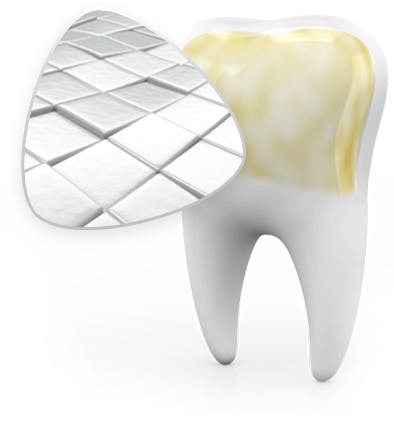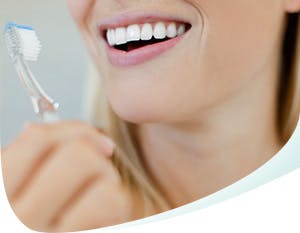What Is Remineralization? How to Remineralize Your Teeth
Enamel protects the inner layers of your teeth from dietary acids.1 Once enamel wears away, it can’t repair itself.1 However, it is possible to repair and strengthen weakened enamel – a process known as ‘remineralization’ – and protect your teeth from future erosion.3 Learn what causes your teeth to lose minerals and how to remineralize your teeth to keep them strong.
What Causes Teeth to Lose Minerals?
Enamel can wear away for a variety of reasons, but one reason for erosion is the acids in your diet.2 These acids attack your tooth enamel, wearing away the minerals that keep it strong – a process called ‘demineralization’.2,3 Over time, this weakens your enamel, and the loss of minerals may behin the softening of teeth and lead to changes in the shape and thickness of the enamel.4 Read our guide to learn more about what causes tooth wear.
The good news is, before it’s worn away, acid-weakened enamel can be repaired and those important minerals can be restored. This is called ‘remineralization’.3
Remineralization, Demineralization and Our Diet


Remineralization occurs when vital mineral ions—like calcium—bond to the teeth to fill in weakened areas of enamel.3

Saliva can help facilitate this process by delivering important minerals to your tooth enamel.3 In addition, the important minerals come from the foods you eat, such as cheese and other dairy products, fiber-rich fruits and vegetables, poultry and seafood.4

Dairy products and other calcium-rich foods can aid in tooth remineralization by replacing the missing minerals in your teeth.4
Find out more about how to actively repair tooth enamel.
5 Tips on How to Remineralize Teeth
With the right oral hygiene and a remineralizing toothpaste and mouthwash, you can strengthen your enamel and help protect against acid erosion.
1. Increase Saliva Production
One of the most effective ways to repair tooth enamel is to maximize the amount of saliva you produce. This is because essential components in your saliva – such as calcium and phosphate – can neutralize harmful acids in your diet and help remineralize your teeth.4 Saliva is also your body’s natural defense against acid erosion.3
Chewing sugar-free gum helps to keep that all-important saliva flow up, protecting your enamel from acid wear and demineralization.4 Always look for gums with the American Dental Association Seal of Acceptance.2,4
2. Drink More Water
Rinsing your mouth with fluoridated tap water after eating or drinking acidic foods and drinks can help prevent tooth decay and promote remineralization, because water helps to neutralize the acids and help deliver the minerals in your saliva back to your enamel.3,4
3. Use a Remineralizing Toothpaste and Mouthwash
Opt for a toothpaste clinically proven to help rebuild enamel strength, like Pronamel. Pronamel is a specially designed remineralizing toothpaste that penetrates deep into the enamel surface and strengthens acid-weakened enamel to help protect your teeth every time you brush. Pair your remineralizing toothpaste with Pronamel’s Intensive Enamel Repair Mouthwash forenhanced enamel protection. Learn how Pronamel toothpaste actively strengthens weakened tooth enamel.
4. Eat a Remineralization Diet
Certain foods can help remineralize softened areas in your teeth that acidic foods and drinks have weakened. For example, foods rich in calcium (dairy products like milk, cheese and yogurt) help put back minerals into the enamel, and fiber-rich fruits and vegetables encourage saliva flow.4
5. Dodge Acidic Drinks
Drinks that contribute to tooth demineralization include sodas, sports drinks and fruit juices. In addition to their sugar content, these are all highly acidic and can wear down enamel – a combination that puts you at greater risk of demineralization and tooth decay.2
Take Steps to Remineralize Teeth
You can help remineralize your teeth by following the tips above and adopting a good dental hygiene routine with products like Pronamel’s Intensive Enamel Repair Mouthwash and a remineralizing toothpaste from the Pronamel range designed to strengthen and reharden enamel. You should also pay regular visits to your dentist to spot early signs of demineralization.
Find out where to buy Pronamel and start your journey to healthier, stronger teeth.
Source Citations:
- Tooth. Mouth Healthy. https://www.mouthhealthy.org/en/az-topics/t/tooth. Accessed on 30/03/20.
- Dietary acids and your teeth. Mouth Healthy. https://www.mouthhealthy.org/en/az-topics/e/dietary-acids-and-your-teeth. Accessed on 22/01/20.
- Demineralization–remineralization dynamics in teeth and bone. International Journal of Nanomedicine (2016). https://www.ncbi.nlm.nih.gov/pmc/articles/PMC5034904/pdf/ijn-11-4743.pdf. Accessed 30/03/20.
- The Best and Worst Foods for Your teeth. University of Rochester Medical School. https://www.urmc.rochester.edu/encyclopedia/content.aspx?ContentTypeID=1&ContentID=4062. Accessed 22/01/20.




